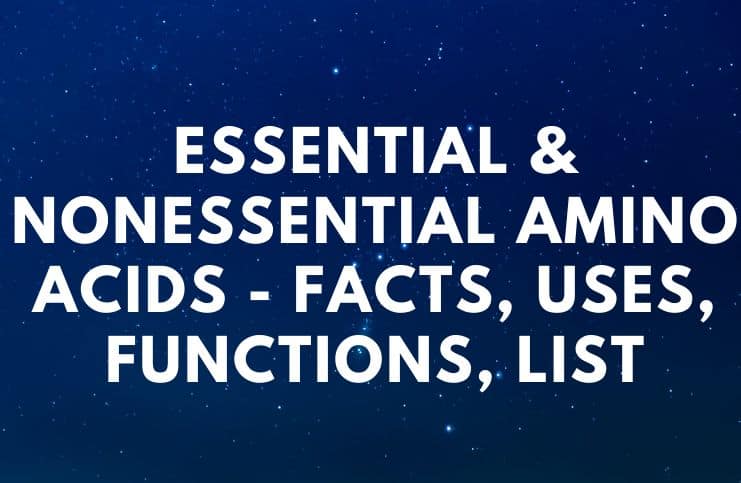Essential & Nonessential Amino Acids – Facts, Uses, Functions, List:
Facts
Amino acids are organic substances on which, following metabolic reactions, usually proteins are built and degraded. Practically, they are constituents of proteins.
All proteins contain the same 21 amino acids but in various combinations (including other components – carbohydrates, lipids, inorganic elements, etc.) and chemical arrangements.
Of the 21 amino acids, 9 must be supplied through diet, and the other 12 can be produced by the body even if they were not present in the diet.
All about proteins
The 9 amino acids that can not be synthesized are called essential or “indispensable.”
The term “essential” applies in nutrition to any nutritional component that can not be produced in the body and, consequently, must be present in the diet. It refers not only to amino acids but other substances as well: fats (omega 3, omega 6) and vitamins.
Some experts place histidine (His) on the list of essential amino acids, but it is indispensable only to infants, as adults are able to synthesize it.
Here is the role of each essential amino acid in the body:
Valine – it was discovered in 1901 by Emil Fischer, a German scientist. It is recognized as the branched-chain essential amino acid providing a stimulant activity. Its deficit in the diet causes a decrease in food consumption and disorders of movement coordination.
Lysine – it is a component of tryptophan and methionine. A deficit of lysine in the diet leads to blood circulation disorders, a low number of red blood cells and hemoglobin content, muscle fatigue, bone calcification disorders, headache, nausea, vomiting, and anemia.
Methionine – it normalizes the metabolism of lipids and phospholipids in the liver and is recommended for prophylaxis and treatment of atherosclerosis. Methionine is necessary for the functioning of adrenal and the synthesis of adrenaline.
Threonine – its lack leads to a shrinking of body mass and slow growth. It is used to treat numerous nervous system disorders, including multiple sclerosis, familial spastic paraparesis, spinal spasticity, and amyotrophic lateral sclerosis.
Tryptophan – it participates in the synthesis of albumin and globulin and maintains the nitrate balance, the synthesis of serum proteins, hemoglobin, and nicotinic acid, and plays an important role in the prevention of pellagra.
Phenylalanine – it participates in normalizing the functions of the thyroid and adrenal glands. Due to the fact that norepinephrine affects mood, different types of this amino acid have been used to treat anxiety and depression.
Histidine – it participates in the synthesis of hemoglobin. The decarboxylation of histidine contributes to the formation of histamine, which dilates blood vessels and increases the permeability of their walls.
Leucine – it helps normalize the balance of nitrogen, and protein and carbohydrate metabolism. It is the most abundant of the BCAAs – three branched-chain amino acids in muscles (the other two are valine and isoleucine).
Isoleucine – it’s a component of the body’s proteins. Similar to all essential amino acids, isoleucine has an acidic group named a carboxylic acid, and a basic group called an amine as part of its structure. The lack of isoleucine in the diet causes a negative nitrogen balance. A deficiency may occur due to the isoleucine-free diet in a maple syrup urine disease or methylmalonic acidemia.
Essential amino acids list:
| Histidine * | Lysine | Threonine |
| Isoleucine | Methionine | |
| Leucine | Phenylalanine |
* Histidine is considered nonessential to adults and children over one year
Nonessential amino acids list:
| Alanine | Arginine * | Ornithine |
| Asparagine | Cysteine | Proline |
| Aspartic acid | Glutamine | Serine |
| Glutamic acid | Glycine | Tyrosine |
* Together with histidine, it is indispensable to very young children
Essential amino acids are necessary for the synthesis of important biological substances in the body: thyroid hormones, catecholamines (phenylalanine/tyrosine), serotonin (tryptophan), histamine (histidine), etc.
Remember!
Protidic metabolism doesn’t have the means to store proteins or amino acids (like in the case of carbohydrates or lipids), so it is important that the raw material is brought daily in the small mobile storage called “amino acid metabolic pool”.
This storage is renewed continuously with amino acids derived from the diet and metabolism, but not as quickly so that it is necessary to eat all the essential amino acids at every meal – a minimum daily intake is enough for the proper functioning of the metabolism.
Caution
Essential amino acids are synthesized only by plants, during photosynthesis, from inorganic matter. Animals and humans can not synthesize these substances, so they get them from food.
Abuse of proteins and amino acids, essential and non-essential, causes various disorders, especially in the long term, because the residual nitrate excess that results from catabolism is harder to convert and remove from the body.
Naturally, the amino acids from food, after digestion and absorption, reach the bloodstream and then the cells, where their metabolism occurs.
It was found that free amino acids, as found in some supplements, cause disturbances in the balance of amino acids because they are absorbed before the release of similar substances from food. This gap can lead to toxic phenomena.
References https://www.britannica.com/science/amino-acid https://www.khanacademy.org/science/biology/macromolecules/proteins
